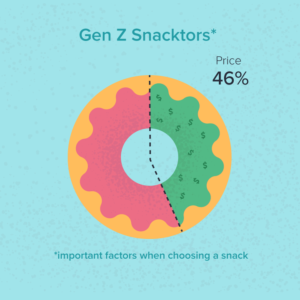Generation Z loves to snack! Born roughly between 1995 and 2010, Gen Z grew up during the Great Recession of 2008, which shaped their identity as a fiscally conscious generation, especially when compared to their brand-conscious predecessors, the Millennials. Gen Z’s financial mindfulness is apparent in their snacking habits, where Gen Z-ers are replacing conventional meals with more affordable and convenient snack alternatives. To learn more about how snack brands can successfully win over price-sensitive Gen Z-ers, we launched a snacking survey targeting 2,500 Gen Z-ers ages 13-24 years in the U.S.
Our study found that 46% of Generation Z snackers are price conscious, citing price as an important factor that they look for in a snack.

We admit that this percentage surprised us, especially after reading the numerous studies detailing Generation Z’s frugal nature. We decided to examine the data on price-conscious Gen Z snackers in depth, in order to understand more about who they are and how they differ from Gen Z snackers who do not consider price to be important.
1..Female snackers watch their wallets more than males.
Among Generation Z-ers who consider price an important factor of a snack, 51% are females versus only 47% males (while 2% do not identify with either gender). This trend is upheld in studies among Millennials, which also report that females tend to be more price conscious as well.
2. .Older Gen Z-ers are more likely to pinch pennies on snacks.
As Gen Z-ers increase in age, they are more likely to be price conscious when choosing a snack. Within the age group covered by our study (ages 13-24), a clear trend of price consciousness versus age emerges, with 53% of 22-24 year olds considering the price of a snack, compared to only 36% of 13-15 year olds.
3. Students who live on-campus have more money to burn on snacks.
When looking at the living situation of Gen Z adults (ages 19-24 years), those who reside in student housing/dormitories are the least likely to look at the price of a snack (42%), preferring instead snacks that are healthy and portable. Adult Gen Z-ers who live with a housemate are the most price-conscious (63%), followed by Gen Z-ers who reside with a partner (58%). Along with the previous insight, we can conclude that older Gen Z-ers who live independently are most likely to be price conscious. One explanation could be that with more financial independence, Gen Z-ers become more aware of and sensitive to price.
4. Price-conscious Gen Z snackers are emotional eaters.

Price-conscious snackers are 56% more likely to snack as a result of negative emotions, compared to snackers who do not watch their wallets. These negative emotions may stem from stress over finances, as our previous insight shows correlation between financially independent Gen Z-ers and price consciousness. And according to earlier insights on emotional snacking, emotional eating, like price consciousness, is a trait more common among female Gen Z snackers.
5. Price-conscious Gen Z-ers are replacing the conventional three meals a day with snacking.
Recent studies find that Gen Z is more likely to snack as a replacement for sit-down meals. Our study found that meal replacement is 15% more likely among price-sensitive Gen Z-ers, compared to non-price sensitive snackers. Lunch is the most common meal that price-conscious Gen Z-ers skip, with 46% replacing lunch at least once a week with snacks.
6. Snackers of nuts & seeds are willing to spend peanuts. Price conscious snackers are more likely to consume snack foods that are more satiating and ‘filling’ in nature. 57% of Gen Z-ers who snack on nuts and/or seeds care about the price of a snack, compared to the 46% of overall Gen Z snackers. Snackers of dried meat (jerky, pork rinds, etc.) and granola bars are also more likely to be price conscious.
7. Economy-minded snackers are true “foodies”. Price-conscious Gen Z snackers are 29% more likely to be weekly watchers of social media-based cooking videos (from publishers like Tasty, So Yummy, etc.) and 29% more likely to weekly watch traditional television cooking shows (The Food Network, Masterchef, etc.), compared to non price-conscious snackers. They’re also 38% more likely to pursue cooking and baking hobbies.
8. These snack brands are more popular among Gen Z-ers who watch their wallets. Compared to non price-conscious snackers, price-conscious snackers are more likely to prefer these snack brands.
9. These snack brands are loved by both price-conscious and non-price conscious Gen Z-ers alike. Although price-conscious Gen Z snackers have distinct demographic and behavioral traits, they like some snack brands just as much as non price-conscious Gen Z-ers. The brands loved by Gen Z snackers, regardless of price sensitivity are:
Price-sensitive Gen Z snackers are financially independent young adults with purchase power in hand. These newly minted adults look to balance a full and vibrant lifestyle with a sustainable income. By replacing meals with snacking, consuming more satiating snack foods, and cooking at home, price sensitive Gen Z-red can still live their best lives without breaking the bank.
Studies show that when making purchases, Gen Z places more emphasis on price compared to previous generations. In order to win over the Gen Z market, snack brands should therefore learn from successful brands like Oreo, loved by both price conscious and non-price conscious Gen Z-ers. Oreo is successful due to its top-notch brand marketing that builds the perception of product superiority and creates cultural and social influencers, winning over otherwise price-sensitive Gen Z-ers who want to be part of the buzz.
Although getting in Generation Z’s wallets is hard, getting in Gen Z’s heads can be even more difficult ﹣but it doesn’t have to be! By truly understanding the motivations and purchasing behaviors behind price-conscious Gen Z-ers, brands can better appeal to these price sensitivities by focusing on increasing the perceived value of their brand.

